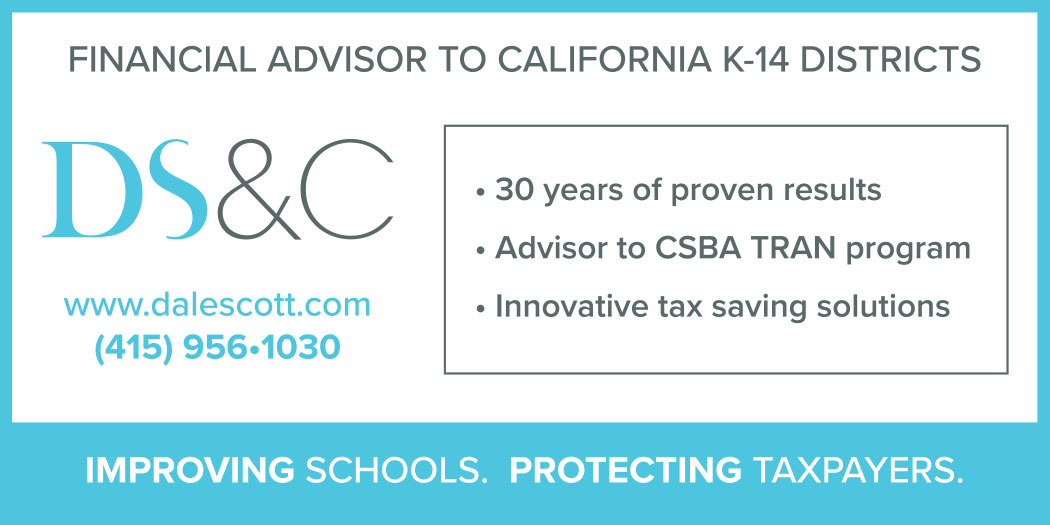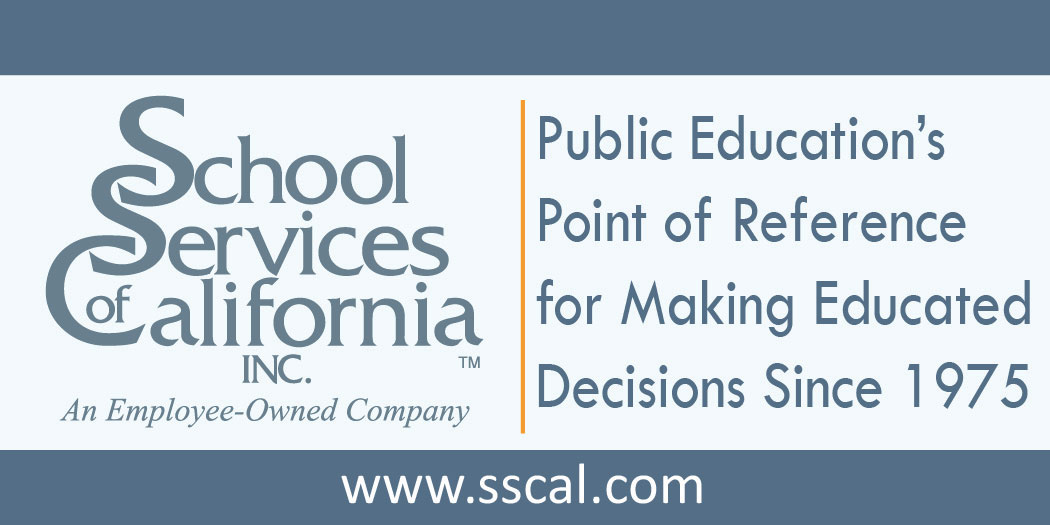

“This is a one-size-fits-all approach that is opposed by teachers and school boards,” the Governor said in his veto message. “Several schools have already moved to later start times. Others prefer beginning the school day earlier. These are the types of decisions best handled in the local community.”
Needless to say, we agree — as do the hundreds of school and county board members and superintendents who sent messages and letters to Gov. Brown urging his veto throughout September. Hundreds more kicked in veto messages of their own in mid-September when CSBA began running radio ads throughout the state urging members of local communities to also contact the Governor to request a veto.
CSBA’s “What’s New for 2019” report is available at www.csba.org/legislativenews, detailing each bill signed into law by Gov. Brown, which will take effect on Jan. 1, 2019.
- Visit www.csba.org/Newsroom for links to digital versions of current and past issues of California School News.

governance

The State Board of Education approved California’s first Computer Science Standards at its Sept. 6 meeting and reviewed changes to the California School Dashboard, previewing a more user-friendly version and adding criteria to the College/Career Readiness indicator.
The new Computer Science Standards are a sign of progress but come with challenges. The standards are voluntary and are not accompanied by supporting elements such as curriculum frameworks. Developed by educators, the standards stress hands-on learning to enable students to proactively interact with computer systems and design. They will cover six core computer science concepts, including algorithms and programming, and seven core practices. The CDE is also aiming to boost participation among underserved student groups, such as African-Americans and Latinos, who have had less access to computer coursework and infrastucture. But how the state plans to reach these students is not yet clear.
“CSBA supports the standards but has also stressed the importance of providing resources that will allow for successful and equitable implementation,” said CSBA CEO & Executive Director Vernon M. Bily.

Troy Flint | tflint@csba.org
Managing Editor:
Kimberly Sellery | ksellery@csba.org
Marketing Director:
Serina Pruitt | spruitt@csba.org
Staff Writers and Contributors:
Hugh Biggar | hbiggar@csba.org
Aaron Davis | adavis@csba.org
Diane Greene | dgreene@csba.org
Graphic Design Manager:
Kerry Macklin | kmacklin@csba.org
Senior Graphic Designer:
Carmen Rodriguez | crodriguez@csba.org
Mike Walsh | Butte COE
President-elect:
Emma Turner | La Mesa-Spring Valley SD
Vice President:
Xilonin Cruz-Gonzalez | Azusa USD
Immediate Past President:
Susan Henry | Huntington Beach Union HSD
CEO & Executive Director:
Vernon M. Billy
News and feature items submitted for publication are edited for style and space as necessary.


“If you can’t measure it, you can’t improve it.” Those are the words of Peter Drucker, one of the world’s most renowned thinkers on organizational management. I read his work often as I worked toward my college degrees in organizational management. I reflected on that quote as I was reviewing, with mixed feelings, the results from the most recent state standardized tests. Students demonstrated modest progress in both English and math — a welcome change from 2017 when scores were flat — but that encouraging note was undercut by the stubborn achievement gap, which shrank only slightly for Latino students and not at all for their African-American peers.
Now, I’m quick to acknowledge that students are not widgets and that scholastic experience is more than what can be measured in a spreadsheet or a bar graph. At the same time, I’m mindful of our mission as governing board members: to provide all students with a high-quality education that prepares them for success in college, career and civic life. Test scores are not the sum of this work, but they are critical indicators that demonstrate our effectiveness (or lack thereof) in important areas.
The numbers make it abundantly clear that we need to focus our efforts on closing the achievement gap. The recent test scores in English language arts reveal a 26.9 percentage-point achievement gap between Latino and white students, slightly down from 2017. Even more alarming is the 33.8 percentage-point divide between African-American and white students, which didn’t move a bit from 2017. Gaps of this size were evident across all tested grade levels and while we’ve made some strides since the current testing system was implemented in 2015, the progress isn’t coming fast enough. One observer noted that, at the current pace, it would take generations to see equitable outcomes for African-American and Latino students when compared to their white and Asian peers. I wish that were hyperbole, but it’s sadly true.
governance/policy
A school district’s budget is the policy document that reflects the vision and priorities of the district. The budget is the guide for your board and administration on making financial decisions for the district.
There are two required reviews of your district’s current year budget, the first is in December and the second is in March. The first interim report is your board’s first look at real numbers for the current year and it shows the revenues and expenditures through Oct. 31. This review provides the board with an opportunity to ask questions and gain a better understanding of the current budget and projected trends.
- Are the district priorities being funded? Is the Local Control and Accountability Plan being implemented? Does the budget support the programs that will make the most of learning and achievement for all of the students in our district?
- Are we deficit spending? In other words, do our expenditures exceed revenues? If yes, is this planned deficit spending?
- Do we have a structural deficit where our expenditures exceed our revenues on an ongoing basis?
- If we have a structural deficit, what are some of the areas that we might want to consider making cuts in?
- Are the Projected Year Totals, which represent the district’s revised budget, better than our original budget or worse? Why?
- What do you think is an adequate reserve to maintain and why?
- Does the Multiyear Projection section include any assumptions that are not board approved? If so, what are these assumptions?
The responses to these questions will help guide your board to making informed decisions. District budgets are covered in the School Finance module of the CSBA’s Masters in Governance Course 3.
Crowdfunding is becoming an increasingly popular method for the public to voluntarily provide support for education. For example, Donors Choose reports that it has collected nearly $736 million and fulfilled over 600,000 classroom project requests since its establishment in 2000. GoFundMe claims an average of $70 million per year for 100,000 projects.
“Crowdfunding through internet platforms such as GoFundMe, Donors Choose and similar sites opens up new opportunities for districts, county offices of education and school-affiliated organizations to raise funds for projects, equipment or supplies,” said CSBA Senior Policy Manual Consultant Diane Greene. “It is one more tool for addressing the needs of our schools and students, along with more traditional types of fundraisers by parent-teacher organizations, student organizations, educational foundations and corporate sponsorships.”
In general, donations received through crowdfunding should be subject to the same conditions and criteria as donations received through other means. However, the unique nature of such platforms may raise additional considerations that should be addressed in district policy.
accountability
That was the case with the 2017–18 Smarter Balanced Assessment Consortium exams which revealed the same modest overall improvement and persistent achievement gaps that have characterized results in recent years. The new and unwelcome twist this season was a regression at the high school level that offset progress among elementary and middle school students.
The SBAC is the foundation of the California Assessment of Student Performance and Progress, California’s standardized testing system. The assessments in English language arts/literacy and math are administered to students in grades three through eight and grade 11. This year, 3.2 million students took the test with 49.9 percent meeting or exceeding grade-level standards in ELA, while just 38.7 percent of students met or exceeded grade-level standards in math. Overall, the performance represented an increase of 1.3 percentage points in ELA and 1.1 percentage points in math from 2017, a year when scores remained largely even with the 2016 results. In total, California students have gained 6 percentage points in both ELA and math since 2015, although the greatest growth came during the second year of the current system when standardized test results usually spike as students adapt to the new exams.
In the news release announcing the latest test results, State Board of Education President Michael W. Kirst pointed to the progress demonstrated by students in the elementary grades as a hopeful sign. Overall, reading scores for third-grade students rose by 4.3 percentage points and by 3.6 percentage points for fourth graders, while math scores in those grades increased by a smaller amount, but still made the largest leap at any grade level.
governance
CSBA’s Nominating Committee met on September 15 to interview the following candidates for President-elect and Vice President of CSBA. For President-elect: Xilonin Cruz Gonzalez, Azusa USD. For Vice President: Suzanne Kitchens, Pleasant Valley SD; Gregory Krikorian, Glendale USD; Alisa MacAvoy, Redwood City ESD; Tamara Otero, Cajon Valley Union SD.
Following deliberations, the Committee nominated Xilonin Cruz-Gonzalez as a candidate for President-elect. As candidates for Vice President, the committee nominated Suzanne Kitchens, Gregory Krikorian, Alisa MacAvoy, and Tamara Otero.
As provided in CSBA’s Standing Rules, qualified individuals interested in being nominated from the floor of the Delegate Assembly must submit a complete Declaration of Candidacy packet along with their written intention to run, on or before Thursday, Nov. 1, 2018. Intentions to run from the floor for President-elect and Vice President must be submitted to CSBA’s President, Mike Walsh at mwalsh@csba.org, and the Chair of the Nominating Committee, Lisa Kaplan at kaplan4kids@gmail.com.
For more information on the nomination process and to review the 2018 candidate criteria used by the Nominating Committee, please visit the CSBA website at www.csba.org/election.
— Lisa Kaplan, Chair 2018 Nominating Committee, Delegate Region 6, Natomas USD, On behalf of the Delegates serving on the Nominating Committee.

The state’s current accountability system highlights this issue: two-thirds of the 228 districts receiving differentiated assistance based on their 2017 Dashboard reports were identified based on their outcomes for students participating in special education.
California’s ongoing efforts to improve services for students with disabilities now include major changes to special education teacher preparation. All of California’s teacher education programs must now conform to new program standards aligned with new teaching performance expectations by the fall of 2020.
The changes are the result of years of research as part of the state’s commitment to meeting the needs of students with disabilities. In 2013, the California Department of Education convened a task force to address persistently low educational, social, health and economic outcomes for the state’s nearly 775,000 students with disabilities. In its 2015 report, the California Statewide Task Force on Special Education described an educational system that essentially functions as two separate systems: general and special education. The task force found this separation reflects teacher education programs that prepare the state’s educators and recommended a comprehensive series of reforms.
Dyslexia is the most common learning disability in California, affecting up to 20 percent of the population. This means that, statistically, every classroom in California has several students with dyslexia who struggle to acquire literacy skills. October is National Dyslexia Awareness month in the United States and provides a timely reminder to revisit California’s Dyslexia Guidelines.
In 2015, the California State Legislature passed Assembly Bill 1369, which required that the California Department of Education create state Dyslexia Guidelines to assist teachers and parents in identifying, assessing and supporting these students. The guidelines were developed with input from an expert working group and published in August 2017.
“California’s Dyslexia Guidelines offer ways to improve the educational experience for students with dyslexia. They provide evidence-based information on how to identify and work with children who struggle with literacy skills,” said Cawley Carr, president of the International Dyslexia Association of Northern California.
The start of the school year is a good time for county office of education board members to consider heading back to class. Professional development training can help sharpen trustees’ leadership skills, create networking opportunities and provide insights on trending topics.
Ongoing changes in law and state mandates for board members, including new features of the California School Dashboard, charter schools oversight requirements and funding and facilities issues, are just a few of the topics that can be addressed in professional development training.
“The success of our students and our districts hang on our knowledge and understanding of the complex and at times overwhelming layers of rules, regulations, laws and mandates we as county and district board members face,” said Heidi Weiland, a CSBA Director-at-Large and a trustee with the El Dorado County Office of Education.
In California, there are a range of professional development opportunities to help facilitate this process. Each year, CCBE holds its annual conference in Monterey, which focuses on the unique issues that impact county board members. Also held each year is the CSBA Annual Education Conference and Trade Show. The 2018 AEC takes place in San Francisco, Nov. 29–Dec. 1, and offers workshops, resources, networking opportunities and inspiring speakers aimed at delivering practical solutions to help governance teams from districts and county offices of education improve student learning and achievement. To learn more and register, visit aec.csba.org.
CABSE Annual Conference
The Brown Act
MIG Course 5
CSBA Annual Education Conference and Trade Show
2019 Institute for New and First-Term Board Members
MIG Courses 1 and 2
2019 Institute for New and First-Term Board Members





